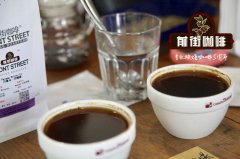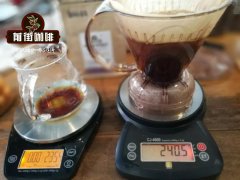The skill of making coffee by hand | what's the difference between one-size-fits-all and segmented extraction?

Professional coffee knowledge exchange more coffee bean information please follow the coffee workshop (Wechat official account cafe_style)
The most common hand flushing technique is probably one-off flow and segmented extraction.
One knife stream
The name sounds interesting, much like a martial arts move in a martial arts novel. The essence of this cooking technique is to do only one uninterrupted injection of water after steaming.

The coffee powder can be continuously soaked in water, the retention liquid can fully release the aromatic substances in the coffee powder, the flow velocity increases continuously, and the water flow is reduced before the water overflows the filter cup.
The main control of one-cut flow is the amount of water injection and flow rate, can achieve the whole section without losing the sense of balance, inappropriate water injection, will destroy the overall sense of balance of coffee.
The main purpose of this method is to maintain a peaceful flavor and a sense of balance. What is not so good is that, because the water injection technique is not well controlled, the water falls through the filter paper on the edge in the upper position where there is no coffee powder, so that the coffee produced may be underextracted.
Segmented extraction
As the name implies, water injection is divided into several stages. Inject a section of water into two or three stages after steaming.

Segmented extraction can get richer layers than one-knife flow, and can clarify the flavor of the front, middle and back stages of coffee. The practice is to increase the amount of water each time after steaming, usually when the coffee liquid is about to drop to the surface of the powder layer, and use small, medium and large water flow to do three-stage extraction. However, segmented extraction will have higher requirements for the flow rate and flow rate of water.
A few days ago, a friend asked whether it was necessary to raise the water temperature or fine grind when using one-size-fits-all to make coffee. So the editor thought about it and simply took the parameters of segmented extraction to use an one-size-fits-all method to cook and see what it would be like if the parameters were basically the same and only the technique was changed.


Segmented extraction + [Polsa, Guatemala]
The palate has obvious aromas of plum and passion fruit, sour and sweet and soft, with chocolate aromas of raisins, plums and almonds in the middle, with plum fruit and biscuit aromas in the mouth.
One-stop flow + [Polsa, Guatemala]
The entrance is as sour as plum, with nutty, chocolate-like sweetness in the middle, and a touch of Chinese fir and cut tobacco in the finish.

Through this comparison of the two methods, in the case of basically the same parameters, the coffee extracted by one-knife flow will be more balanced, and the level change will not be too great, while the method of segmented extraction can get a cup of coffee with rich layers and varied flavors.
Important Notice :
前街咖啡 FrontStreet Coffee has moved to new addredd:
FrontStreet Coffee Address: 315,Donghua East Road,GuangZhou
Tel:020 38364473
- Prev

Coffee roasting skills | what is taxiing? Effect of taxiing on the flavor and taste of coffee
Professional coffee knowledge exchange more coffee bean information please follow the coffee workshop (Wechat official account cafe_style) contact coffee roasting friends, I believe they all know a term: gliding. Taxiing emphasizes that the baked beans can be roasted continuously and slowly by using the residual temperature of the boiler and the temperature produced by the heat released during the burst period under a very small fire or off fire. Using taxiing techniques, you can
- Next

Coffee hand-brewing skill | practical parameters of "steaming" time for coffee extracted with 6 different utensils
Professional coffee knowledge exchange more coffee bean information please follow the coffee workshop (Wechat official account cafe_style) steaming, which is often expressed as Bloom in the English instructions, which refers to the preparatory action of wetting a small amount of hot water evenly on the surface of coffee powder during hand flushing before formal water injection. It is at some stage in the process of making coffee that you cover the coffee, also known as coffee.
Related
- Beginners will see the "Coffee pull flower" guide!
- What is the difference between ice blog purified milk and ordinary milk coffee?
- Why is the Philippines the largest producer of crops in Liberia?
- For coffee extraction, should the fine powder be retained?
- How does extracted espresso fill pressed powder? How much strength does it take to press the powder?
- How to make jasmine cold extract coffee? Is the jasmine + latte good?
- Will this little toy really make the coffee taste better? How does Lily Drip affect coffee extraction?
- Will the action of slapping the filter cup also affect coffee extraction?
- What's the difference between powder-to-water ratio and powder-to-liquid ratio?
- What is the Ethiopian local species? What does it have to do with Heirloom native species?

